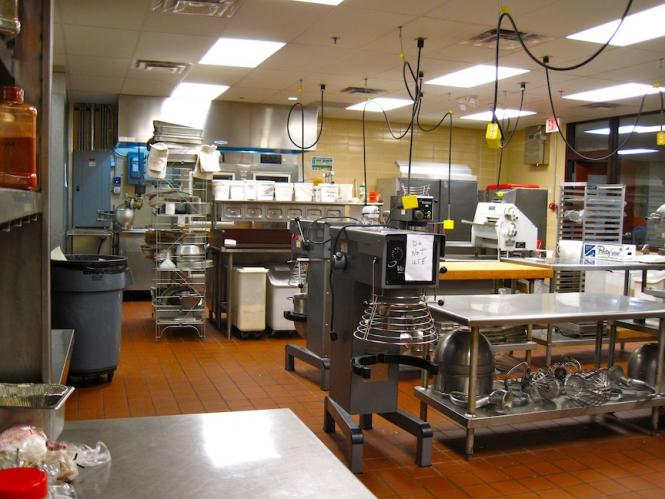This is the eighth article in a series about attending Culinary School. Also check out posts on Seafood Class, Menu Planning, Cooking in Quantity, Poultry Class, Wine Tasting Class, Winemaking, and the Introduction to the series.
Now that school’s out for the summer, I’ve had a chance to reflect on my first year as a full-time culinary student. The first two semesters have had their ups and downs, but overall, I’ve had an incredibly rewarding year on so many levels. Here are some anecdotes about the best and worst parts of my first year in culinary school.
Strangest Thing I Tasted: Smoked Oryx
One of my teachers routinely conducts cooking experiments in the school’s kitchen. He integrates these projects into class by giving us shared tastes. In the mornings, I always looked for the telltale signs a project was in process and searched for plates of samples; over the course of the year, I tasted jalapeño-bacon wrapped chicken livers, smoked halibut, venison sausage, and freshly tapped maple syrup. But by far, the most unusual thing I tasted was smoked oryx. He had attained the oryx meat from a friend who had a connection to a farm in Texas, and I was surprised when it tasted familiar, like venison sausage.
Most Annoying Aspect: The Uniforms
I loathed our school uniforms, especially our pants. As a petite individual, I knew I was doomed to an ill-fitting uniform. The white, see-through pants came in unisex sizes and were lined with stiff waistbands. We paid a hefty fee for uniform cleaning service, as well as a $250 deposit each semester. When the company returned them to us, they were starched to the extreme. To top it all off, we wore white baseball caps, which came in a one-size-fits-all. I fought with my hat every morning and I could never seem to adjust it tightly enough. The bill fell in my eyes, so I frequently collided with other students, doorframes, and the edges of counters. One day after school, I wrote an ode to my culinary school pants, unleashing a year’s worth of pent up frustration. Soon after, Fargo-Moorhead’s newspaper published what was intended to be a comical blog post written for my own amusement. Soon, my disdain for my pants was no secret. We all had a good laugh, including my instructors.
Most Embarrassing Moment
Shortly after my pants article was published, I found myself face to face with a representative from the uniform company – AmeriPride – when we had to return our uniforms on our last day of class. The company then determined whether we were eligible to receive our deposit back. If a uniform piece was missing or in poor condition, they’d charge about $80 for each cheaply made linen. When it was my turn, the representative said I was missing two jackets. I reacted in surprise. “Two jackets? How could that be possible? We were only supposed to have five jackets and I returned six!” My teacher found the whole situation hilarious, given that I, the student who had complained about my uniform, was one of the only students missing anything. When I got home, I promptly found both missing jackets and sheepishly returned them with a profuse apology!
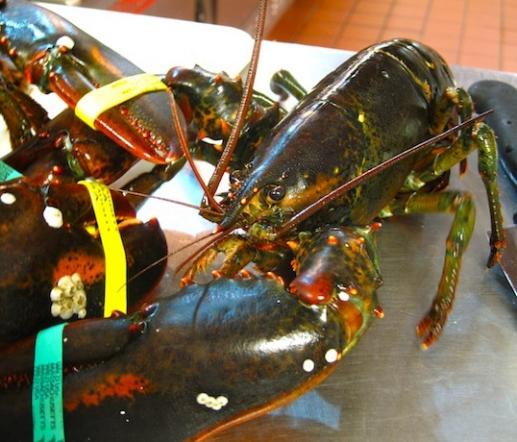 My most embarrassing moment that never happened
My most embarrassing moment that never happened
Most Embarrassing Moment That Never Happened
Apparently, I’m afraid of lobsters. On the last day of Seafood Class, our teacher ordered live Maine lobsters. As she unloaded them from their crate and passed them around the class I almost fainted, but not quite.
Least Favorite Food I Prepared: Twice Baked Potatoes
In my update about Quantity Lab, I mentioned that the last students to arrive at class got relegated to potato duty. This poor sap happened to be me on the day twice-baked potatoes appeared on our menu. Outside of culinary school, I see twice-baked potatoes so often that I used to forget how much work they entail when prepared from scratch, but I got reacquainted quickly. Plus, the already arduous process becomes especially lengthy when preparing the potatoes in bulk. It goes something like this: Scrub potatoes and drain. Rub with oil and sprinkle with salt and pepper. Bake for at least an hour. Remove from oven and play hot potato. Carefully remove tops. Scoop fluffy into giant stand mixer while they are still hot without puncturing the skin. Mix with sour cream, butter, cheese, salt, pepper, and chives. Scoop scalding hot mixture into a pastry bag and pipe into empty potato shells. Bake until golden brown. Add shredded cheese and bake until cheese melts. Place on steam table and hope everyone appreciates your hard work.
Favorite Cafeteria Meals:
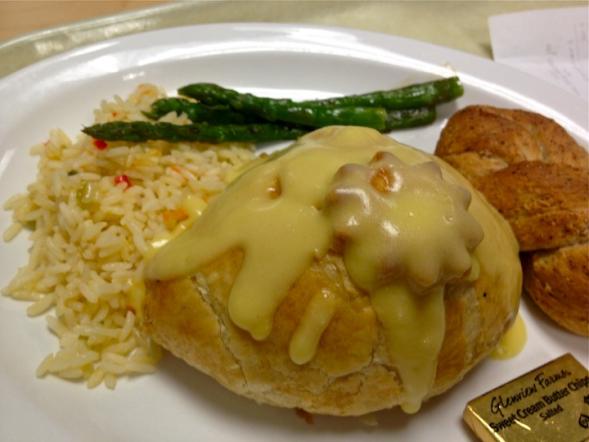 My favorite meal, Chicken Oscar
My favorite meal, Chicken Oscar
Chicken Breast Oscar: Not only was this one of my favorite meals to prepare and eat, but one of the most fattening and starchy. Coincidence? I think not. We spent a morning in butcher lab flattening chicken breasts, rolling them around a mixture of cream cheese, green onion, garlic, and Krab (fake crab), and wrapping them in rich puff pastry. Next, we affixed a decorative pastry leaf to each packet, brushed them with egg wash, and baked. They were served with a few sprigs of asparagus, hollandaise sauce, bell pepper-flecked rice pilaf, and a dinner roll with, what else, butter.
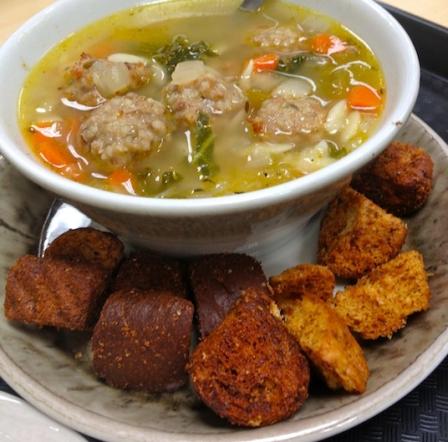 Tony's Italian Wedding Soup
Tony's Italian Wedding Soup
Homemade Soup: As culinary students, we received a $3 credit towards lunch each day. More often than not, I was content with a humble bowl of soup. I remember especially enjoying the knophela soup that I made (see the recipe here), a black pepper infused carrot-ginger soup, and my lab mate Tony’s Italian wedding soup made with homemade meatballs, kale, and orzo. Tony is what I consider an intuitive cook, or one who’s been around the culinary block long enough to cook from the heart and add his or her own flourishes to a recipe with mostly successful results. I kept my eye on the daily soup-makers and always knew whose bowls I wanted to eat.
Least Favorite Meals:
Philly Cheesesteak Soup: Even with my preference for salty, cheesy, rich foods, this soup defeated me. The recipe called for an outrageous 15 cups of cheese. And as if the cheese wasn’t rich enough, the soup also contained steak and heavy cream, which rendered the fresh bell pepper and onions obsolete. Against my better judgment, I chose this soup for lunch and knew I was in trouble when it quickly solidified. I struggled through half a bowl and then felt ill for the rest of the day.
Shepherds Pie: I didn’t like it before I prepared it in culinary school, and I still don’t
Most Surprising Things I Learned:
Healthy and Vegetarian Food Doesn’t Sell. Students occasionally raised concerns we didn’t offer enough healthy or vegetarian options. And I agree that this option was generally lacking. Blue-plate specials, while delicious, are often high in fat. The grill menu also poses many temptations, and students order burgers, grilled cheese, chicken strips, and curly fries on a regular basis. While the menu offers a broth-based soup and creative green salad each day, I can see how one could tire of them.
But the unfortunate reality is that healthy food and vegetarian options don’t sell well. I’ve noticed creative vegetarian sandwiches and wraps for sale, however many of them went to waste because no one bought them. Our teachers told us that one persistent student had requested veggie burgers on the grill menu. When the school purchased a case, so few people actually bought them that most were discarded after they passed their expiration date. I also found myself wishing there were more enticing healthy options, though I understand the cafeteria can’t sustain itself if it doesn’t sell what’s purchased. I hypothesize that healthy foods could sell better if the school eliminated unhealthy food from the menu. But then again, I don’t like the idea of eliminating all junk foods because adults should be able to make their own healthy choices.
The Steamer Rules. Serving breakfast and lunch for an entire school meant we made large quantities of foods that had to hold up in a steam table during meal service. Therefore, we prepared food in the most efficient method possible and this often involved the commercial steamer. I had no idea it could cook so many different foods including eggs, rice, and steamed vegetable sides. I was most fascinated to learn I could cook potatoes for potato salad and mashed potatoes in the steamer more quickly and efficiently than boiling them on the stovetop.
Favorite Cooking Project: Peking Ducks
One of the most exciting cooking projects was making and eating Peking ducks in Poultry Class. You can read more about our adventure in this update. It was a lengthy process but not too unwieldy to replicate at home. I enjoyed this unexpected taste of Chinatown in Fargo-Moorhead.
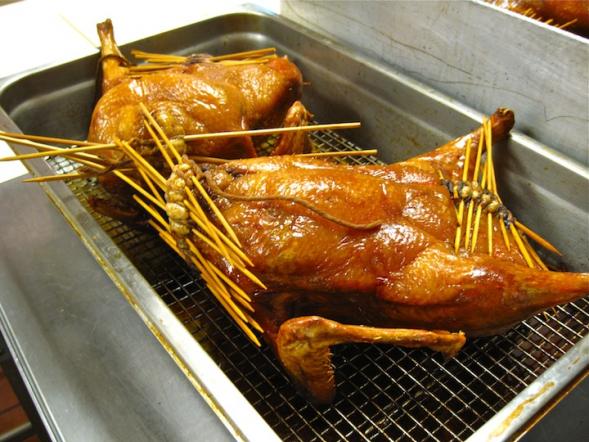 Peking Ducks
Peking Ducks
Most Gluttonous Moment: Attending Food Shows
Each semester, we were invited to attend a local food supplier show, free of charge. It was challenging to exercise restraint amidst a wonderland of processed foods. Tables were loaded with samples including fruit slushies, pieces of pie, platters of fried chicken fingers and shrimp, and roast beef, just to name a few. The group seemed to favor ice cream cones at the Sysco show, while the US Foods show even offered a wine and beer tasting garden.
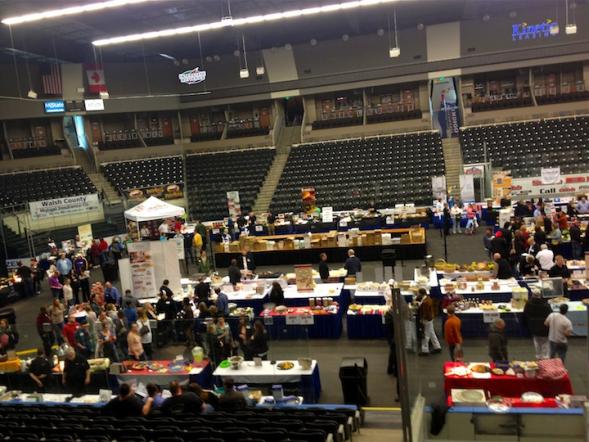 Sysco Food Show
Sysco Food Show
Memorable Cooking Fail: Banana Cream Pie
I don’t know one student who hasn’t had a do-over or needed a quick fix. At the beginning of each semester, I saw at least one student trying to cook pasta by placing it in cold water and trying to bring the pot to a boil, leading to an inevitable do-over. My particular do-over involved banana cream pie custard in baking lab. When it was time to cook the custard, I utilized a small conduction burner to that could only be adjusted to certain temperatures, since stovetop space was scarce. In the blink of an eye, the mixture sized up and curdled into scrambled eggs. My teacher came to the rescue and instructed me to push it through a sieve and run it through the food processor in batches. This was still a time consuming process, but faster than starting over and much less wasteful.
Favorite Tips/Tricks: Making Pie Crust and Scones and Using Parchment paper.
Before culinary school, I had never made piecrust or scones because the process intimidated me. But when I was enrolled in baking lab, I couldn’t avoid making scones and piecrust around Thanksgiving and Christmas. We baked apple and pumpkin pies that filled the school’s dessert cases and that we sold to faculty and students to take home for the holidays. There were several mornings we furiously slung out as many pies as possible..
A certain degree of technique is needed to create a flaky piecrust and scone, but I loved the unfussy method with which my teacher approached the processes. She showed us how to form pie dough by hand, using our fingers to integrate the room temperature lard and ice water into the flour without a lot of pomp and circumstance. We were always pressed for time and one morning before a breakfast buffet, I remember curiously watching her prepare scone dough in the stand mixer. She set the paddle to mix at a vigorous pace as the cut warm shortening into the flour. They turned out as light and flaky as ever.
Finally, I quickly learned to line my pans with parchment paper. During the first week of baking lab, I assumed it was enough to grease my pan instead of taking the time to cut out a parchment paper liner. Later, I spent a considerable amount portion of my morning desperately prying bars from the pan and trying to squish them into presentable squares. From that point forward, I lined every pan with parchment paper, to the extent that my teacher sometimes told me to remove it. The one exception was angel food cakes, which I was told to leave alone.
Least Favorite Task: Cleaning The Electric Tilt-Skillet
Earlier this spring, I chuckled as I read the article, 9 Crucial Things You Won’t Learn In Culinary School published on Buzzfeed. In one section, the author claims culinary school doesn’t teach students how to clean anything. Her education cost $38,000 and she graduated without knowing how to clean a fryer, gas range, or floor. She was also surprised she had to take out the compost while working at real restaurants. All I could think was, “Girl, where on earth did you go to culinary school?”
At community college culinary school, we learned how to clean everything. Heck, the supervising students showed us where the trash bags, dumpster, and compost bins were and how to run our own dishes on the first day. If we used a piece of equipment, we were expected to clean it. We gathered together on the very last day of class each semester to deep clean the kitchen from top to bottom and this was no optional task. My least favorite activity was cleaning the electric tilt-skillet. I did just about anything to avoid using it, but there were times where the recipe called for a quantity too large to juggle on the burners. It’s not that the tilt-skillet was hard to clean, but it was more that the process was annoying. There was nowhere to drain the skillet, so all of the cleaning water and debris had to be collected into a bucket and dragged to the disposal on the other side of the kitchen. Being too small to lift the full bucket, I always felt sheepish asking for help.
Favorite and Least Favorite Tastes from Wine Class:
My favorite wines I sampled in wine tasting class were port, sherry, and Gewürztraminer. I was not surprised to find I still hated extremely sweet wines.
Most Surprising Things I Learned in Wine Class:
When we transitioned to winemaking (from wine tasting), I was surprised to learn that red grapes can produce white wines because the color results from contact with the grape skin. I still find it amusing that bung and bunghole are actual winemaking terms.

Most Frustrating/Rewarding Aspect: My Classmates
In my first culinary school update, I compared our class to a family, and I didn’t mean a Hollywood family. I meant a real life family complete with the usual suspects like one’s favorite cousins, little siblings, a bossy older sister, a fun aunt, and maybe a creepy uncle. By far, the most frustrating part of culinary school was working with individuals who didn’t carry their own weight in the kitchen, though this is not unlike many school group projects. Everyone is admitted into the program on a first come, first serve basis so students come from all walks of life and with varying levels of knowledge about food preparation. Students didn’t necessarily need to have a lot of kitchen experience, because those with a good work ethic and willingness to take on new things excelled. However, those who skipped a lot of class or refused to take initiative created more work for others. Students could flunk out with time or pass with low grades, but there was really nothing we could do about the slackers except adjust our frame of mind by considering the extra work learning experience. On the plus side, the students who were present and hardworking tended to get to know each other better and bond.
Despite this frustration, the most rewarding part of culinary school was still my classmates. I learned from the personal knowledge and experiences they brought to the table inside and outside of the classroom. We managed to have a lot of fun even on the most stressful days, and it wasn’t always just about food. During our lunch breaks we shared YouTube videos, studied for tests, went to student services events like grocery bingo and free massage day, and talked about our favorite books. Culinary school greatly increased my general knowledge about food. I’m also excited I no longer avoid foods I was previously intimidated by because I was forced to make them (under helpful supervision). Just as importantly, I grew as an individual and connected with a group of individuals I might not have gotten to know otherwise. I have an immense amount of respect for the students who worked ungodly hours to pay for class and managed to give their best effort.
It’s been an honor and privilege to be a part of this culinary school family.
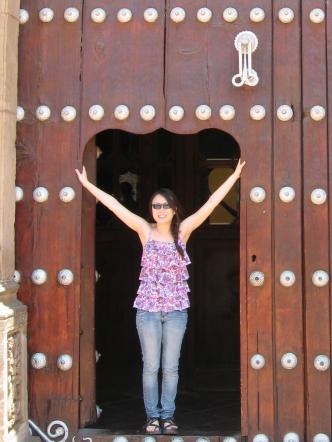
Jeni Hill grew up in the Twin Cities and recently moved to Fargo. Her two sustaining passions are food and writing and she combines the two whenever she gets the chance. Jeni believes food is never just about the food and considers it the finest medium to connect with others. When she is not crafting contributions to Simple Good & Tasty, she may be posting to her blog An Herbalist Eats, 20food, or Fargo's High Plains Reader. Her last series for SGT was Farm to Fork, a CSA Series.

